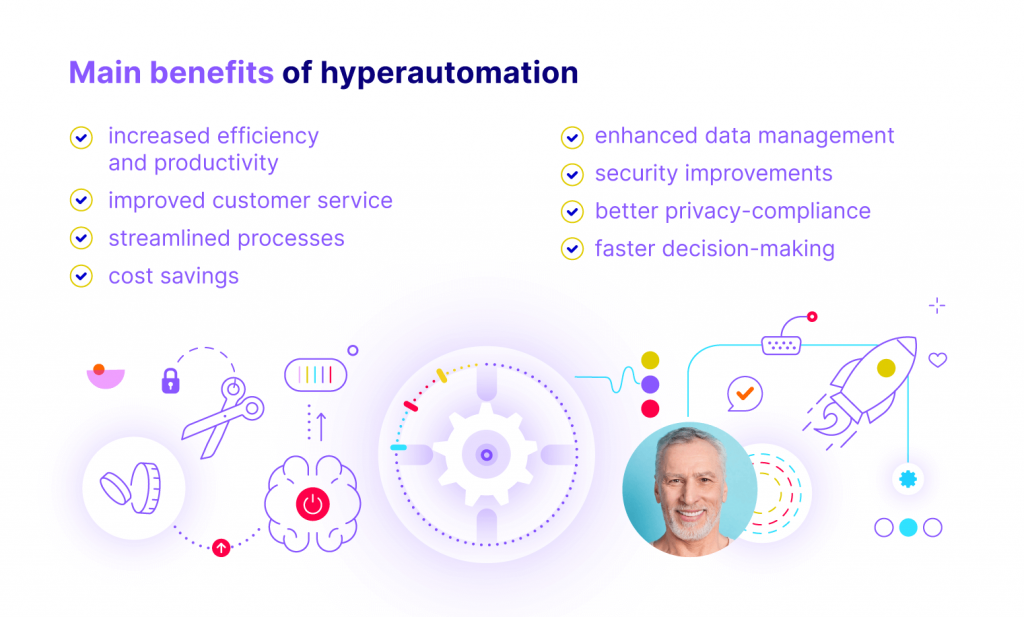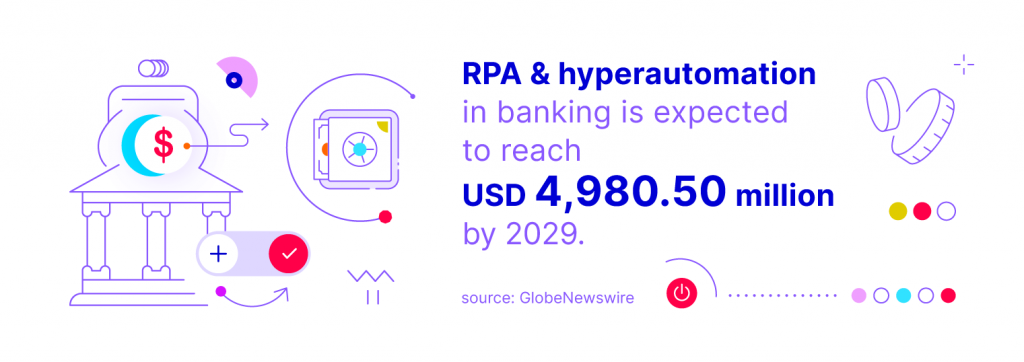How hyperautomation is transforming the shape of today’s business
- 18.03.2024
- 9 min
The change from traditional automation to hyperautomation has become a key to success for modern enterprises. In its basic form, automation has long been a key driver of operational efficiency. However, hyperautomation in business takes this concept to a new level, combining advanced technologies to enhance and streamline business processes. In this article, we explore the evolution of automation, the role of artificial intelligence (AI) in hyperautomation, and how businesses harness its power.
What is hyperautomation
Hyperautomation is an advanced approach to automation that leverages cutting-edge technologies, such as AI, machine learning (ML), and robotics, to automate a broader range of processes and tasks. It represents a significant evolution from traditional automation by incorporating more sophisticated technologies to handle complex tasks that were previously challenging or expensive.
The main benefits of hyperautomation in business include:
- Increased efficiency and productivity: organisations can automate more complex tasks, freeing up human staff for more critical and creative work.
- Improved customer service: automated systems, including chatbots, respond instantly to inquiries and provide personalised experiences.
- Streamlined processes: by automating processes, hyperautomation reduces manual errors and improves accuracy, leading to more streamlined operations.
- Cost savings: hyperautomation in business helps save costs associated with manual labour and operational expenses, contributing to overall cost efficiency.
- Enhanced data management: automated systems collect and analyse data in real-time, offering valuable insights into customer behaviour and trends.
- Security improvements: hyperautomation reduces the potential for human error, enhances data security, and helps organisations manage access to sensitive information.
- Better privacy-compliance: automated systems assist in complying with industry regulations and standards.
- Faster decision-making: hyperautomation eliminates manual approval processes, facilitating faster and more informed decision-making.

The evolution from traditional automation
Traditionally, businesses have employed automation to eliminate repetitive tasks, reduce errors, and enhance productivity. The shift towards hyperautomation marks a significant advancement, incorporating AI, ML, and other technologies to automate complex processes that were once considered beyond the reach of traditional automation.
The importance of hyperautomation in business lies in its ability to bring about efficiency, cost-effectiveness, and agility. It enables organisations to focus on innovation, customer experience, and strategic decision-making rather than manual, time-consuming tasks.
Traditional automation typically focuses on automating repetitive and rule-based tasks. Hyperautomation expands this scope to include more complex cognitive tasks that traditionally require human intervention. This allows businesses to automate a broader array of processes across various departments.
Hyperautomation in business is often part of broader digital transformation initiatives. It works in synergy with Big Data analytics, cloud computing, and the Internet of Things (IoT) to give organisations a holistic view of their operations. This integration enhances decision-making capabilities and helps businesses allocate resources more effectively.
Traditional automation systems often lack the flexibility to adapt to changing conditions. Hyperautomation introduces adaptability and agility through AI and ML, allowing systems to evolve and optimise based on real-time data and changing business requirements. By leveraging advanced analytics and ML algorithms, organisations can better understand their operations, customer behaviours, and market trends.
Learn more about optimising processes and increasing efficiency with business automation.
The role of AI in hyperautomation
AI plays a pivotal role in hyperautomation, providing the ability to analyse data, make predictions, and continuously learn from it. Moreover, generative AI is gaining prominence in the automation landscape. Gartner reports on generative AI highlight its diverse applications, tools, and models, emphasising its role in creating unique content, designs, and solutions. In 2024, generative AI applications are expected to go mainstream as businesses leverage their capabilities to enhance automation processes.
Hyperautomation in business uses various innovative technologies, such as:
- AI and ML that enable systems to learn, adapt, and make data-based decisions.
- Robotics that plays an important role in industries like manufacturing, automating physical tasks, and leading to lights-out factories.
- Chatbots that provide instant responses and assistance, improving customer interactions.
- Data analytics that is leveraged by hyperautomation to gather insights from large datasets, aiding in decision-making and process optimisation.
- IoT that is utilised to gather real-time data from interconnected devices, contributing to a more comprehensive understanding of operations.
- Cloud computing that provides the flexibility and scalability required for deploying and managing hyperautomation solutions.
Main automation trends for 2024
As AI takes centre stage in today’s digital transformation, organisations are eager to translate its potential into prominent benefits. Hyperautomation in business emerges as a powerful tool for fast-tracking AI development. The integration of automation is going to help organisations make use of their innovations swiftly and efficiently, providing much-needed progress in transformative technologies.
Now, let's delve into the main automation trends that will define the business in 2024.
Combining AI with automation
Certain AI and automation solutions are expected to witness rapid growth and adoption. Intelligent document processing (IDP) is the leader because of its ability to deliver significant and sustained value. Other use cases, such as communications mining, process and task mining, and automated testing, are gaining momentum, showcasing their potential to drive efficiency and innovation.
Increasing transparency of organisations
The most successful organisations leverage AI-powered processes and task mining to gain end-to-end visibility into their operations. This approach allows businesses to diagnose bottlenecks and inefficiencies swiftly, ensuring optimal performance. Transparency becomes a key focus, enabling continuous improvement and optimisation of workflows.
Understanding the role of large language models (LLMs)
The rise of virtual desktop assistants, often called "copilots," takes centre stage in 2024. These assistants, powered by LLMs, can understand plain language and efficiently execute tasks. As millions of knowledge workers adopt this solution, the way work gets done is set to undergo a significant transformation.
Expanding capabilities with generative AI applications and natural language processing (NLP)
The automation industry harnesses AI's ability to expand machines' capabilities using generative AI and NLP. These technologies enable the auto-creation of significant data and automated tests, enhancing quality and speed of processes’ execution. Introducing self-healing software robots further underscores companies' commitment to pushing the boundaries of hyperautomation in business.
Ensuring the safety and privacy-compliance of AI solutions
Understanding AI's risks becomes a priority and organisations are focusing on implementing governance rules and safeguards. Using “responsible AI" extends to selecting vendors and partners who take privacy-compliance seriously. Governments are expected to introduce new privacy regulations that will emphasise the importance of ensuring that the innovations benefit enterprises, customers, and society.
How hyperautomation influence finance and banking
Hyperautomation in business enhances companies' efficiency, accuracy, and innovation. Adopting and integrating automation technologies will give a competitive advantage and support their evolution.
In 2024, hyperautomation is set to transform the finance and banking landscape even more than ever before. One of its most important contributions is to improve the banking industry's security. With the help of advanced artificial intelligence algorithms, hyperautomation strengthens security measures, particularly in the critical area of fraud detection.
Introducing hyperautomation means that financial institutions can rely on intelligent systems that scrupulously analyse patterns, detect anomalies and quickly respond to potential security threats in real time. Such an approach will minimise the risks associated with fraudulent activity and significantly increase the overall resilience of the financial ecosystem. As cyber threats continue to evolve, the ability to adapt and proactively respond to security challenges is becoming increasingly important to protect sensitive financial data.
Additionally, the impact of hyperautomation extends to the regulatory landscape of the financial sector. Automated processes are key in streamlining compliance activities, ensuring financial institutions follow rigorous industry regulations and reporting requirements. The dynamic nature of the regulatory framework often challenges the traditional manual approach to compliance. Hyperautomation brings speed to the compliance process and minimises the margin for error, increasing regulators' confidence.
Hyperautomation in business, especially in the finance and banking sectors, is changing the game's rules, increasing security, and making compliance easier. It becomes a supporting partner for financial institutions, using intelligent systems to quickly deal with security issues and minimise the risk of fraud. Maintaining a strong and resilient financial system in the face of evolving cyber threats is critical. Hyperautomation also accelerates and streamlines compliance processes, making regulators more confident in the ever-changing world of finance.

What does the future hold
The automation trends for 2024 indicate a profound shift towards increased efficiency, flexibility, transparency, sustainability, adaptability, and innovation. The goal is to create a seamlessly integrated environment where automation, powered by advanced technologies like generative AI, not only streamlines processes but also fosters a culture of continuous improvement.
The role of automation in improving customer experience cannot be overstated, as businesses aim to provide personalised and efficient services. As organisations embrace these trends, they are poised to unlock new levels of innovation and competitiveness in the evolving landscape of hyperautomation in business.
Fintin automates business processes
Hyperautomation in business is at the forefront of transforming the way businesses operate. Integrating artificial intelligence, especially generative AI applications, will redefine the automation landscape as we move towards the future. Fintin is ready to embrace this transformation, offering a robust platform to automate business processes, especially in the leasing, finance and banking industries.
In the upcoming blog posts, we will focus on a few key areas related to business automation, showcasing the variety of solutions available on the market. Our first topic will be the combination of Fintin and the Camunda platform, which shows how to support efficient processes in finance.
Then, we will expand our perspective by adding AI to the equation. We will trace how Fintin, Camunda and AI work together to take automation to the next level, bringing innovative approaches to process management in the financial sector.
We will also touch on the combination of Fintin, SensID and Camunda. This will provide an insight into the advanced automation solutions that result from the integration of these three elements. In particular, we want to focus on cognitive document-based automation using NLP, among others.
Finally, we will dive into the topic of Fintin and cloud computing, especially the services available in such an ecosystem. We will show how this combination allows you to optimise the required infrastructure and also transforms customer service processes, eliminating the need for traditional servers and increasing the scalability and flexibility of operations.
Through these articles, we aim to illustrate the role of various automation tools in finance.
Fintin, in particular, plays a crucial role in driving this automation revolution. As a key player, Fintin facilitates seamless integration with platforms such as Camunda and extends its capabilities when combined with advanced technologies, such as AI, SensID and cloud computing. Fintin's intelligent solutions are here to create a modern and innovative future for the financial world.